The Last Sunset and a Conversation with Space
By Rachel Heckerman, McMurdo Station Correspondent
October 28, 2019
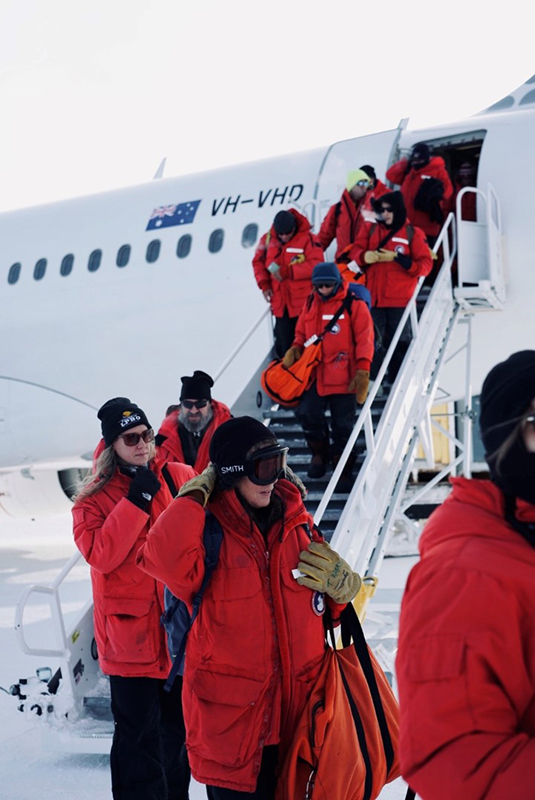
Photo Credit: Rachel Heckerman
US Antarctic Program participants arrive at McMurdo Station, stepping off their plane on Phoenix Airfield's ice runway.
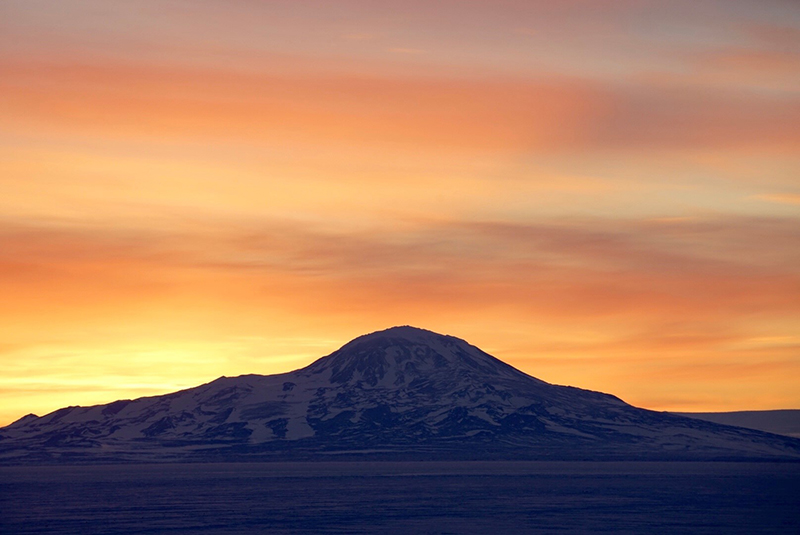
Photo Credit: Rachel Heckerman
Mount Discovery, a dormant volcano in the Transantarctic Mountains visible from McMurdo Station, is silhouetted by the setting sun, one of the last sunsets of the year.

Photo Credit: Rachel Heckerman
The stained glass window in the station's chapel frames the sunset and mountain range off in the distance.
McMurdo Station has swung into full gear as the summer season has officially begun. In just a few short weeks, the roughly 250 people populating the station during "Winfly" — the transitionary time between summer and winter seasons — has climbed to nearly 750, and community life has sprouted vigorously from every crack and corner around town. During this time the establishment of a new community begins; this season bringing a slightly different dynamic than the last. Whether it be dining attendants experiencing Antarctica for the first time, or scientists developing new research, there is something unique happening for all walks of life on Ross Island.
Already the month of October has presented us with many unexpected surprises. One who is new to "the ice" might ask what they could expect from their first season, but the answer to that question is simple—anything here is possible.
One of the highlights so far was in the evening on October 21st McMurdo Station was able to have an hour-long video conference with astronaut Jessica Meir on the International Space Station. With great enthusiasm (and some backflips), she had the galley's full attention. It was an exciting time to talk to her as she and fellow astronaut Christina Koch had conducted the first all-female spacewalk just days before, a milestone in exploration that lasted seven hours and 17 minutes. Both were former members of the United States Antarctic Program; Meir researched emperor penguins alongside physiologist Paul Ponganis, and Koch worked in a number of positions in the program, including as a research associate, on the firefighting teams and ocean and glacier search and rescue teams between 2004 and 2007. On the call, Jessica gave a tour of the space station, charmed us with her micro-gravity water eating, and answered questions from the audience. She told us how every 90 minutes the ISS orbits fully once around the globe—making about 16 trips around Earth every day. Most importantly, she explained how the skills she learned at McMurdo opened the door to many opportunities, leading her on the path to working for NASA. Watching Jessica doing the impossible, from another seemingly impossible place such as Antarctica, was a moment of a lifetime.
Also at the end of October, the sun officially set for the last time for the next four months. What was once a sky of the colorful aurora borealis, has been replaced by a 24-hour stream of sunlight. Each evening leading up to the final sunset, the sun dipped below the horizon approximately 20 minutes later than the day before until there was essentially no sunset left. This phenomenon, the "Midnight Sun" is caused because the Earth is tilted on its axis and where Antarctica is positioned in relation to the sun. During the summer, Antarctica is tilting towards the sun, exposing it to constant daylight, while in the winter it is tilted away. On station, people tried their best to head out and catch a few of the final sunsets — sometimes running out on work breaks or their off hours to snap a few photos. For some lucky individuals who stopped by to watch from the chapel at the right time, they were treated to a pianist playing a quiet melody against the pastel backdrop of the sky.
While the sun has been welcomed by the majority of people here, sometimes it is necessary to shut the blinds to see things a little more clearly. This was the case during the many science talks that have taken place this past month, with presentations by Paul Ponganis, Heather Liwanag, Andrew Mullen, and Amy Moran offering insight into the range of scientific research that has been conducted out on the ice thus far this season. The talks are a good reminder that every role is important at McMurdo, and give station residents a chance to see what they're working towards. People from all different professions are curious and excited about the science that takes place in the lab and in the field.
It is encouraging to see how energetic the town of McMurdo has become over the last few weeks, between old and new friendships alike. So much has already happened in such a short amount of time, and this is just the beginning.
Winter's End
By Isaac Sleadd, McMurdo Station Correspondent
September 12, 2019
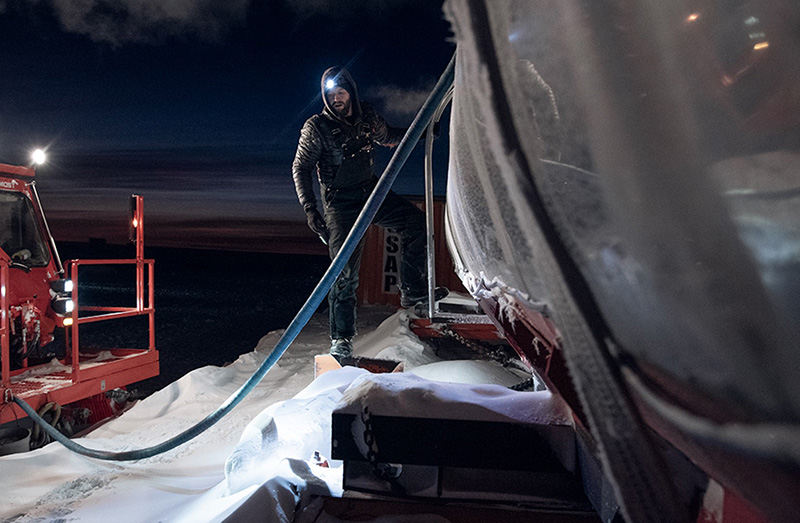
Photo Credit: Kira Morris Geer
Fuelie John Bryan transfers fuel to a fuel tank at Phoenix Airfield.

Photo Credit: Kira Morris Geer
Station residents show off their pinewood derby cars at their specially-made racetrack in Building 155.
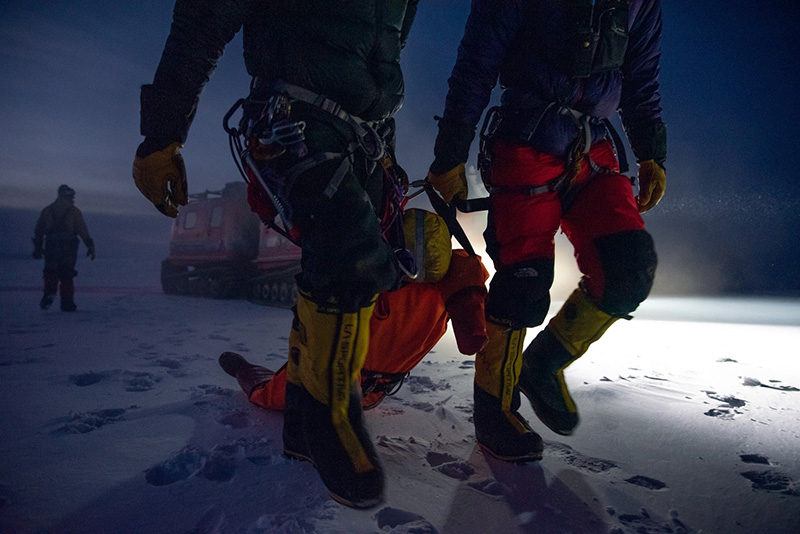
Photo Credit: Kira Morris Geer
Two members of the Search and Rescue team haul an "injured" dummy during the station's Mass Casualty Incident drill.

Photo Credit: Kira Morris Geer
A masked figure makes their way through heavy snowstorm during the spate of bad weather in August.
Much of July was relatively quiet here at McMurdo Station. After the winter flight from New Zealand arrived on July 4th and the town celebrated Independence Day on the 5th, it settled into a familiar routine. Normal "housekeeping" operations continued at their usual pace, and various work centers continued their preparations for "Winfly," the coming shoulder season before the busy summer. The station population normally doubles at this time, and although the pace of life on station is nowhere near as hectic as "Mainbody," the summer season that begins in October, it does bring significant changes to our small community here on Ross Island.
Winfly is normally scheduled to start around the second week of August and this year consists of four flights. The population is expected to double by the end of the operation. For those of us who have spent the long, dark, quiet Antarctic winter here in McMurdo, expectations seemed to be a mixture of trepidation and excitement. Trepidation because the increased energy levels from the sizable population of new arrivals can be somewhat shocking for those still acclimated to the pace of winter. But excitement also because many of friends are returning to the Ice after several months spent traveling the world. Soon they will be arriving with new stories, fresh outlooks, and—if we are lucky—gifts such as avocados and fresh fruit.
Before the onset of Winfly, we had a number of exciting recreation events taking place around station. The population stood at 138, and many of us put our creative abilities to the test in preparation for the “Post-Apocalyptic Party,” held at the Waste Barn. Perhaps nowhere else in the world do people pour their hearts and souls into dressing up for the end times and dancing with their friends in a place normally reserved for sorting trash and recyclables. It was surely a night to remember.
Assistant Area Manager, Pedro Salom also kept things fun by organizing a pinewood derby. He handed out kits to everyone who was interested, and it became a common sight around station to see people sculpting, painting and test-driving their tiny wooden vehicles in their spare time. On the day of the race, a racetrack was constructed in Building 155, and a double-elimination tournament took place with a great deal of hooting and hollering. Awards were handed out for accomplishments as "Best Paint Job," "Funniest," "Fastest," and "Most in Need of Parental Help."
But it wasn't all fun and games. The time leading up to Winfly offered the opportunity to stage another Mass Casualty Incident (MCI) Drill to ensure that station residents are prepared for such an unlikely event. It brought together the fire department, search-and-rescue teams, medical staff, and dozens of volunteers to help keep their training fresh. The event was a success, and we are confident that if a real MCI ever happened, we would be ready to respond swiftly and efficiently.
At the end of August, just before Winfly was about to start, a large weather system rolled into the area, bringing some of the worst conditions we had seen all winter. High winds and blowing snow at times reduced visibility to less than 100 feet, leading to the declaration of "Condition One" on station. This is the most serious weather classification, during which nobody is allowed to leave the building they are in. Poor weather continued for well over a week, and ultimately Winfly would have to wait until early September. Although this meant pushing back a number of work-center projects, mail delivery and the arrival of fresh fruits and vegetables, many of the folks here seemed content to make the best of it and enjoy an extra couple days of winter solitude.
A Midwinter Night's Dream
By Isaac Sleadd, McMurdo Station Correspondent
July 22, 2019

Photo Credit: Kira Morris Geer
Janitor Isaac Sleadd vacuums the carpet in the station store. The pace is slower and quieter during winter, giving winter residents a chance to work on more involved tasks and projects.
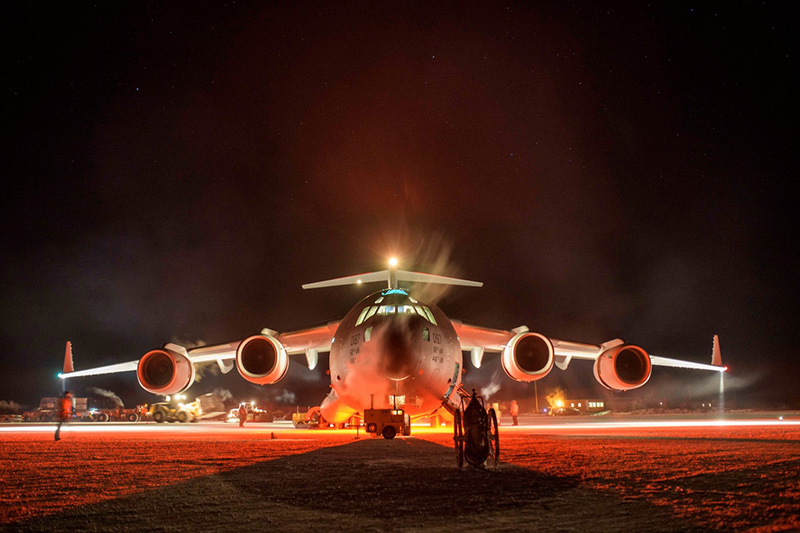
Photo Credit: Stephen Allinger
Parked at Phoenix Airfield, the "June" C-17 flight arrived on July 4 because of weather delays.
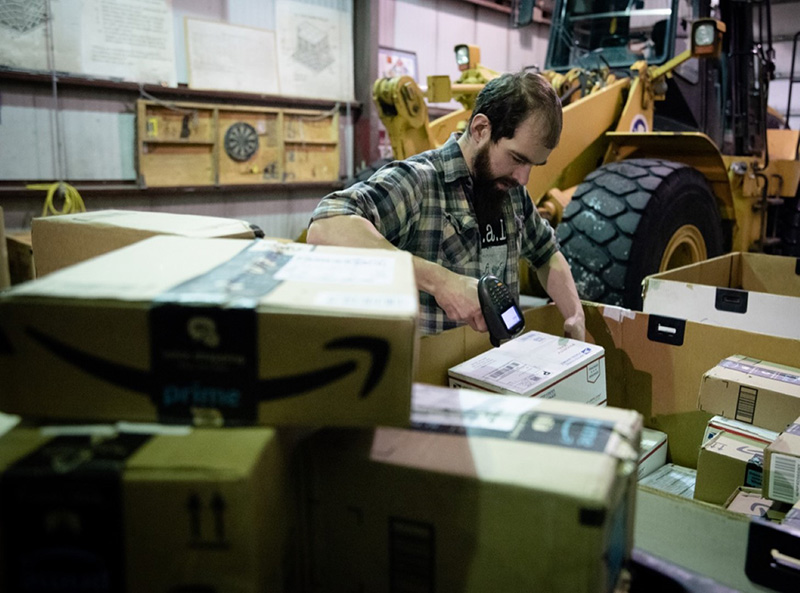
Photo Credit: Kira Morris Geer
James Roth sorts through the piles of mail that arrived on the July 4 flight.

Photo Credit: Kira Morris Geer
Darcy Haskill marches in the Independence Day parade, postponed to July 5 because of the arrival of the midwinter flight the day before.
For the two communities that share Ross Island, Antarctica, the month of June began rather festively: with a birthday party for Queen Elizabeth II, hosted by New Zealand's Scott Base. Revelers from Scott Base and McMurdo Station were encouraged to dress up for the occasion, and an award was handed out for the most obscure queen-themed costume.
By this point, McMurdo had settled into the cold, dark winter months. June was relatively quiet down here, which is a good thing. The extreme weather is known to cause all sorts of difficulties, from minor glycol leaks to brief communications outages, but overall this June was relatively smooth sailing, and we are grateful for that. The various departments could go about their day-to-day tasking and pursue special projects in anticipation of the upcoming summer research season.
Outside of work, it was a great month for music and dancing. Firefighter John Piper put on a solo concert at the Chapel of the Snows. A truly gifted vibraphonist, Piper's performance was titled "Over the Rainbow" and brought together romantic ballads and jazz standards to celebrate love in all its forms. Other musical events around station included a well-attended open-mike night at Gallagher's Pub, featuring everything from Appalachian banjo picking to pop covers and spoken word performances.
One of the most anticipated and best received events this month was the celebration of Midwinter. Although the solstices are celebrated around the world in various cultural contexts, the Midwinter Dinner is a special occasion that is unique to the continent of Antarctica. It has been celebrated down here since the heroic age of exploration in the early 20th century. This year, the galley staff put together an extraordinary menu, and a team of volunteers decorated both the galley and Gallagher's Pub, where after-dinner dancing and socializing took place until late.
The annual June flight, which delivers personnel, mail and fresh fruits and vegetables, was delayed this year due to weather. After more than a week of high winds and blowing snow, the dodgy weather finally subsided, and a flight from Christchurch, New Zealand, was able to land at Phoenix Airfield on July 4th. The arrival of much needed supplies, as well as mail and "freshies," put everybody in a good mood, and the 4th of July parade and party boosted morale even more.
Spirits were soaring at our Independence Day celebration, which began with the world's shortest, darkest, and southernmost 4th of July parade. There were jugglers, a color guard, tracked vehicles called Hagglunds and more. As part of the festivities later, revelers played live-action Hungry Hungry Hippos, got free insults from clowns, had their caricatures drawn by Jay the janitor, posed for pictures at a photo booth and played "Human Jenga." This last activity involves standing on an empty cardboard box and then stacking more boxes, one at a time, until the player is standing atop a wobbly tower of their own design. For their safety, competitors wear climbing harnesses and are belayed by a mountaineer, proving yet again that it is possible to have fun and be safe at the same time.
It has been nearly three months since we have seen the sun, but on clear afternoons, we can see a faint glimmer of light on the northern horizon. It will glow a little bigger and a little brighter every day, until one magic day in August, when the sun will rise again.
Happy Midwinter and Happy Independence Day from McMurdo Station.
Saying Goodbye to the Sun
By Isaac Sleadd, McMurdo Station Correspondent
June 12, 2019
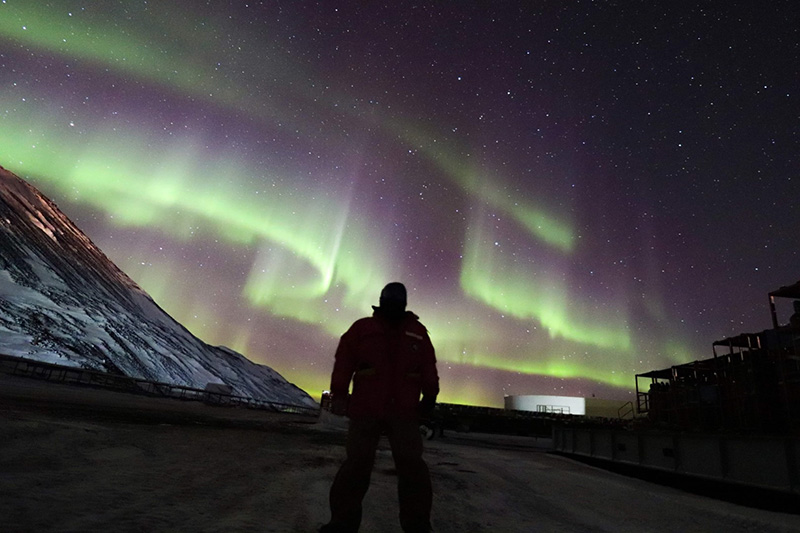
Photo Credit: Danny Hampton
A solitary figure stands outside and observes the auroras overhead.

Photo Credit: Stephen Allinger
Station residents lend a hand to help prepare a scientific balloon for launch.

Photo Credit: Isaac Sleadd
The sun dips below the horizon for the last time until August 19.

Photo Credit: Isaac Sleadd
Residents gathered together to write postcards to friends and family to send on the April flight.
For the residents of McMurdo Station, April began in the usual way, with a smattering of light-hearted April Fools' jokes. Ranging from the elaborate—a fictitious video conference with the Vatican—to the mundane—"Did you hear? The galley has completely run out of cheese." Friends shed crocodile tears, claiming their contracts were ending early or being extended, but the April flight came and went with no actual changes to the list of planned departures. The shoulder season was officially over, and the population dropped to 138—the fewest for this calendar year.
The April flight held a special significance over previous ones, as it marked the beginning of our darkest and most isolated days. On the day of departure, many of us gathered near the frozen sea to watch the plane take off from Phoenix Airfield. We raised our glasses of ginger ale in salute as the plane skirted the Royal Society Range and disappeared into a beautiful pink and orange sunset.
Throughout April, we had been losing daylight. Several recreation trips were organized that allowed people to say goodbye to the sun from either Castle Rock, Erebus Bay Overlook, or Arrival Heights—all of which offer spectacular views of the surrounding ocean, islands, and mountains. If anyone felt uneasy about the upcoming months of darkness, they didn't show it. On the contrary, everyone was looking forward to seeing more stars, planets, satellites, meteors, the Milky Way in all its splendor, and the majestic Southern Lights.
Most of the science in Antarctica takes place over the summer months, when conditions are relatively mild, but two groups of hardy researchers are still here collecting data in the harsh winter months. One team is using lasers to study the middle and upper atmosphere, while the other is launching a series of balloons to investigate aerosols—small particles which impact global climate in crucial ways but are oftentimes difficult to measure using aircraft and satellites.
The annual McMurdo Science Fair, held at Gallagher's Pub, had nothing to do with these well-funded research projects. Instead, community members presented their often whimsical, or at least tongue-in-cheek, findings on which color of galley mug is best (red), which toilet is the most user-friendly (debatable), and which zodiac sign is best represented by the current population (Aries). Live demonstrations included non-Newtonian fluid dynamics, electronic circuits, 3-D printing, and a hodgepodge of small experiments performed live by Dylan, who was awarded "Best in Show." It was a wonderful evening—one that showcased the unbridled levity and creativity of our community.
Here at McMurdo Station, we have introverts, extroverts, and everything in-between. While many people spend their free time pursuing quiet interests such as reading, writing, and crafting, social events do abound. Recreation in April and May included a clown night, live music at the carpentry shop, pub trivia, karaoke, stargazing trips, bad-movie nights, and miniature golf at New Zealand's Scott Base.
At the end of May, residents were looking forward to Midwinter dinner and the first flight in over two months. Whispers of mail and fresh fruits and vegetables could be heard around station, and the truth is that the community here is always excited about something. Even though it is cold and dark, and we work very long hours, a unique brand of optimism pervades this beautiful place.
Settling in For Winter
By Isaac Sleadd, McMurdo Station Correspondent
April 17, 2019
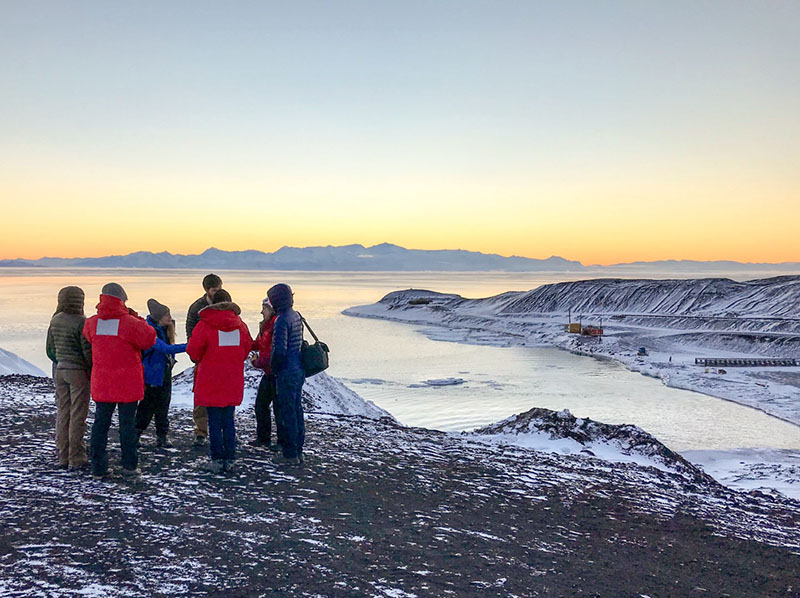
Photo Credit: Isaac Sleadd
With the sun low on the horizon, station residents say their goodbyes before a number of them leave on the flight in March.
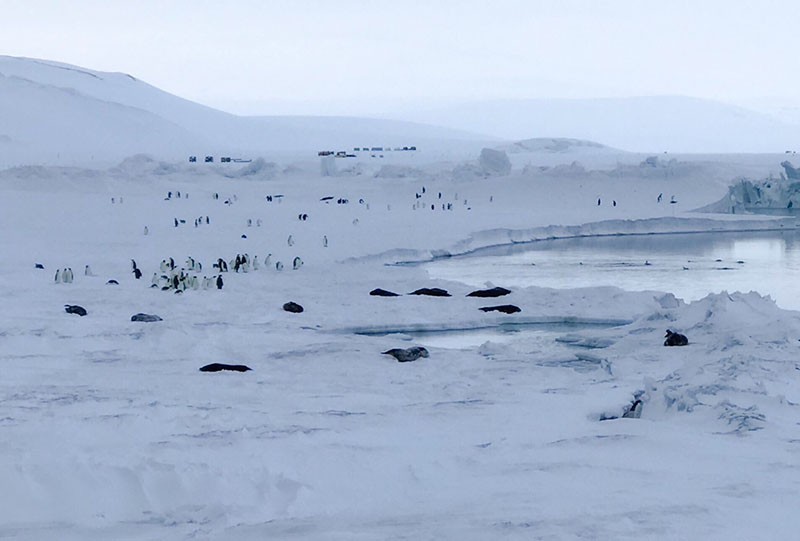
Photo Credit: Isaac Sleadd
Dozens of penguins and seals congregate near New Zealand’s Scott Base after the sea ice broke up.
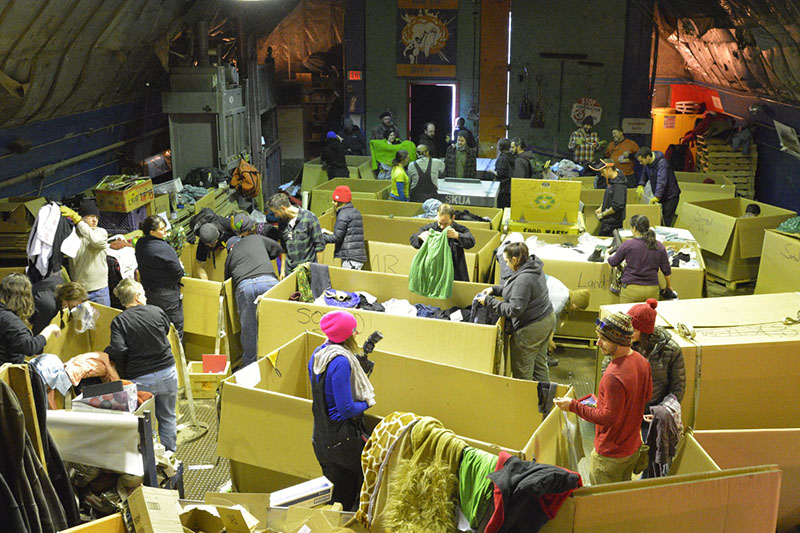
Photo Credit: Chris Simon
Named after the scavenging bird that nests in Antarctica, station residents participate in the annual "skua sorting party" in the waste barn
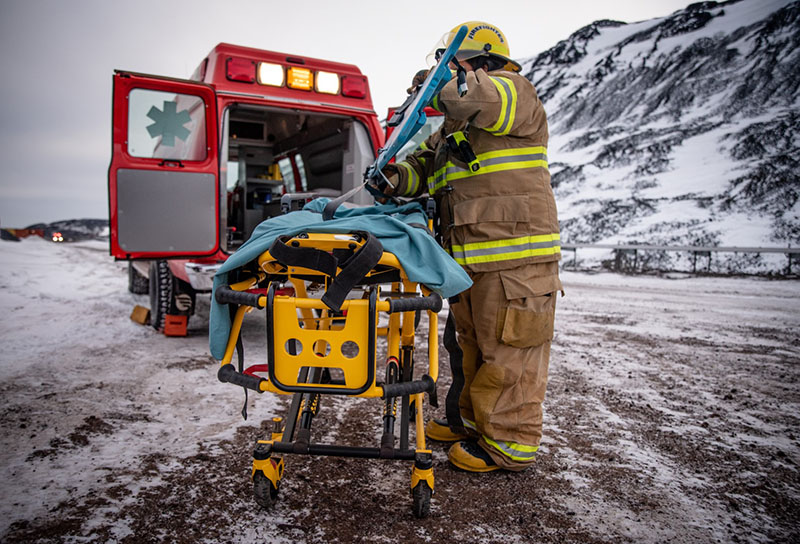
Photo Credit: Kira Morris Geer
A firefighter adjusts a gurney during the station's mass casualty drill.
For McMurdo Station, the month of March is a period of transition. The busy summer’s science and special construction projects have drawn down, hundreds of workers and researchers left the continent, and those of us who remain spent the month easing into the cold, dark and quiet Antarctic winter. Day-to-day operations took on more of a “caretaker” quality as the station turned down to the pilot light for the off-season. Winter in McMurdo is all about maintaining our facilities in some of the harshest conditions on Earth, while at the same time preparing for next summer's busy research season. It is a tough job, but we love it.
To complement our various sociological transitions, Mother Nature underwent some rather dramatic changes last month. With each passing day, the sun spent more and more time below the horizon. People stayed up late to watch the full moon rise. Venus, Jupiter, and Saturn shone brightly in the night sky. The increasing darkness revealed a tremendous number of stars and satellites—things I had not seen in over four months—and by the end of March, the Milky Way was visible. Some lucky individuals even caught a glimpse of the dreamlike Southern Lights (aurora australis), which danced overhead at three and four in the morning.
Perhaps not surprisingly, it has gotten colder here, with wind chills approaching -60 degrees Fahrenheit. Despite the bone-chilling, mustache-freezing temperatures, we at McMurdo Station are still enjoying the outdoors. About half of the Ross Island Trail System is still open to hikers and history buffs have been leading tours to Scott's Discovery Hut (built in 1902) and Hillary's Hut (built in 1956). Skis and bicycles are available to rent year-round, and I am always delighted (albeit somewhat bewildered) to see people riding their bicycles across the ice in a snow storm.
For those who preferred to stay indoors in March, there were plenty of recreation activities available. “The big gym” officially reopened after being beautifully resurfaced, and pickup basketball games became a weekly occurrence. Indoor rock climbing, fitness classes, dance parties, open mic, karaoke, and trivia provided numerous chances to unwind during our demanding 54 plus hour work weeks. There was even a Lego® show in the back of the galley which featured one extremely large and detailed interpretation of a polar research station.
When the opportunity presents itself, we like to have fun in ways that benefit the community. One great example of this is the annual “Skua” sorting party. Named after a local scavenging bird, “Skua” is the term for high-quality items that people give away when no longer needed or wanted. When hundreds of people leave station, as they did in February, countless piles of clothing, costumes, toiletries, books—you name it!—accumulate around station and end up at the Waste Barn for sorting. Music and bingo made for a lively and enjoyable time as volunteers dug through the bins in search of new treasures.
Another important community event was the more serious Mass Casualty Incident Drill. It’s a training exercise held every few months for station residents to practice emergency procedures in the event of a major accident. Teams of volunteers had trained weekly in anticipation of this crucial, station-wide exercise. Firefighters and EMTs, communications and laboratory technicians, stretcher bearers, auxiliary medics, and recorders came together to address a vehicle roll-over scenario. It was a high-adrenaline day, and the exercise was an overwhelming success. Events such as this serve to remind us that while life in Antarctica is often fun and enjoyable, we are still thousands of miles from civilization—in an extremely harsh environment where we must be prepared for anything.
February 2019 in Review
By Isaac Sleadd, McMurdo Station Correspondent
March 15, 2019
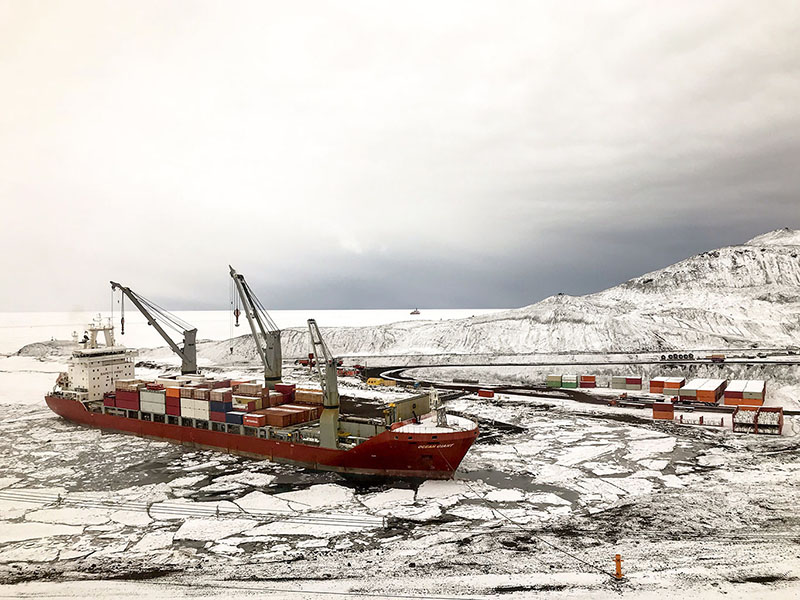
Photo Credit: Isaac Sleadd
The cargo vessel Ocean Giant, docked at the ice pier as station staff prepare to unload millions of pounds of cargo.

Photo Credit: Rose McAdoo
After some blustery weather, the sea ice broke up, exposing the ocean beneath. The seals hardly seemed to notice.

Photo Credit: Rose McAdoo
Station residents watch the sun dip below the horizon for the first time in four months.
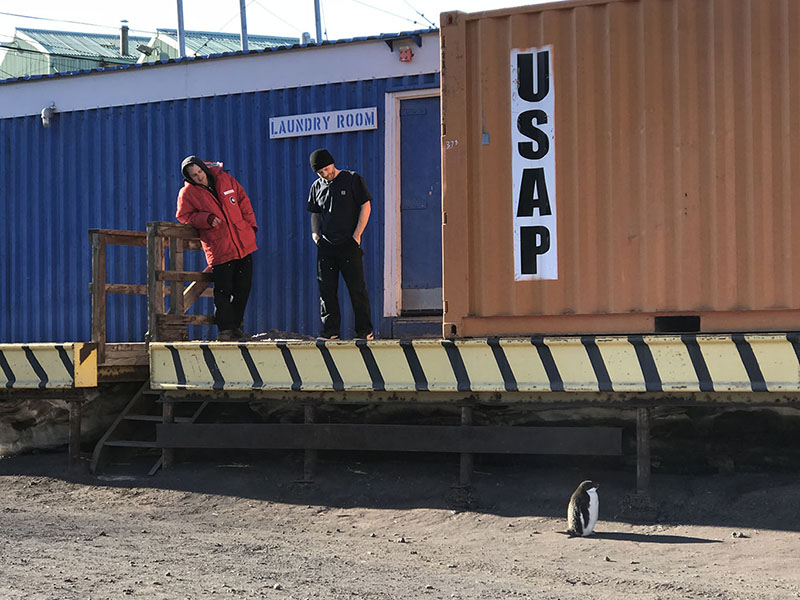
Photo Credit: Isaac Sleadd
Station residents keep their distance as an Adelie penguin wanders through the station.
February began at full-throttle here in McMurdo Station, with the support staff working in shifts to unload our annual resupply vessel, the Ocean Giant. The U.S. Coast Guard icebreaker Polar Star had cleared a channel for the ship's arrival, and she remained nearby throughout the unloading. As soon as the 10.5 million pounds of cargo had been unloaded, teams were tasked with reloading the vessel with nearly as much waste and retrograde cargo bound for the United States. When the two ships finally sailed north, the station breathed a sigh of relief. It had been a hectic, though rewarding time for everyone involved.
The cargo we received included some mammoth concrete footers and steel beams destined for a new addition to the Science Support Center, dubbed the "IT&C Primary." A special construction crew spent the month tackling this exciting project, and it was a joy to watch the framework go up piece by piece. Meanwhile, the service men and women of the New Zealand Defense Force were busy helping distribute and organize supplies, resurfacing "the big gym" and renovating one of the dorms on station.
Early in the month, strong southerly winds brought an unexpected surprise: open water! Piece-by-piece, the sea ice broke up and blew north, leaving shimmering dark blue water all around the peninsula. This was quickly taken advantage of by pods of majestic orcas and minke whales, who delighted onlookers armed with binoculars and telephoto lenses. Overnight, whale watching had become the most popular recreational activity on station.
Perhaps the second most popular recreational activity of the month was put on by the "Stewies" (an affectionate term for the stewards who work in the galley). This hard-working, fun-loving group of people hosted prom (for adults), theme of which was "Under the Stars." The prom committee did a fantastic job decorating Gallagher's Pub, where two live bands played and a DJ spun club music until late. There was a photo booth which stayed busy, and Stewie Brandy was elected Prom Queen. Frosty Boy, our beloved soft-serve ice cream machine, was voted Prom King, although the honor was passed along to the next (human) runner up, Dennis the mountaineer.
One of the most difficult things about February is saying goodbye to dear friends. After the ships had left and the construction projects reached a stopping point, hundreds of people completed their contracts and flew north to warmer climates. This annual migration sees the population of McMurdo fall from just under one thousand people down to around 250 winter and shoulder-season workers. When it came time for each plane-load of people to depart, those of us who were staying behind gathered to form a "tunnel of love" or "hug train" to bid farewell to our friends as they headed to the ice runway. The mood was upbeat, however, with promises to keep in touch and perhaps see each other again when October rolls around and the main summer research season ramps up.
It is feeling more like winter every day now. The sun set on February 20 for the first time in four months, and some particularly determined folks stayed up late to see the spectacle, which occurred at 1:46 am. In less than a week, we had lost five hours of daylight, and there were some especially cold and windy days to remind us of Antarctica's awesome power. What's more, there were numerous, endearing wildlife encounters and spectacular sunsets to remind us of the incredible beauty of this place we call home.
Month in Review - January 2019
By Isaac Sleadd, McMurdo Station Correspondent
February 27, 2019

Photo Credit: Mike Lucibella
Researchers at SALSA pull up a water column sampler from Lake Mercer, a subglacial body of water under three-quarters of a mile of ice.

Photo Credit: Mike Lucibella
Ioffe Lee takes a swing at the annual McMurdo softball tournament.
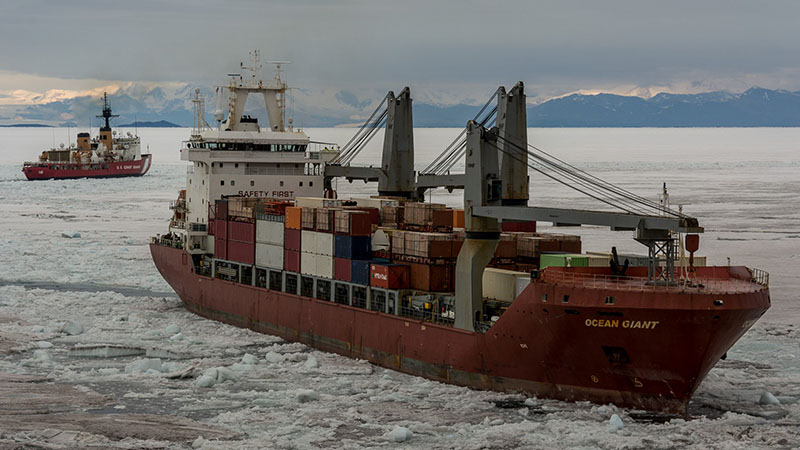
Photo Credit: Mike Lucibella
The cargo ship Ocean Giant (foreground) arrives at the pier carrying cargo for the station, with the Coast Guard icebreaker Polar Star in the background.
January is always an exciting time for McMurdo Station, and this year was no exception. Revelers rang in the New Year at Ice Stock, our annual outdoor music festival, where local bands took to the stage and spectators—some dressed in penguin and dinosaur costumes—danced in the sunshine until the wee hours of the morning. The festivities afforded everyone the opportunity to unwind a little before buckling down for January, one of the busiest months of the year.
It was an exciting month for science. The Long Duration Balloon Facility saw its share of "ups and downs." Two balloon-borne telescopes were launched into the stratosphere but returned to Earth sooner than expected and in locations that made recovery of the instruments difficult. However, the ingenuity and collaboration that went into those recovery efforts exemplified the resiliency which characterizes so many of the scientific endeavors pursued here an Antarctica each year.
Farther afield, researchers and technicians at SALSA Camp successfully drilled into sub-glacial Lake Mercer for the first time. After taking numerous water and sediment samples, the teams packed up and returned to McMurdo, where their joyful exuberance was infectious. Groups of five or ten could be seen in the evenings at the coffee house raising a glass to a job well done. Teams from other deep-field camps returned during this time as well, and happy reunions took place all over station as “townies” were reacquainted with friends who had been gone—some of them for months.
Although Ice Stock had come and gone, the station still had plenty of opportunities for recreation. The wharf provided the perfect place for a friendly interdepartmental softball tournament, and there was some stiff competition as teams battled for nearly seven hours in the falling snow. Spectators cheered and heckled as players gave it their all, and everybody had a great time.
The McMurdo Alternative Art Gallery, another local tradition, was held in the fuels barn. There were original paintings, sculptures, a live portrait studio, performance art, and even fortune telling. Later in the month, the carpentry and waste departments answered in kind with two of their own well-received live music events. The artistic and musical abilities of Antarctic contract workers never cease to amaze.
By the end of January, the population of McMurdo had swelled as personnel from the U.S. Navy and New Zealand Defense Forces joined in to help unload the approaching cargo ship. The U.S. Coast Guard icebreaker Polar Star arrived first to cut a channel through the sea ice, and the crew was generous enough to let the community tour the ship. Some lucky individuals were selected by lottery to go on a morale cruise out to the ice edge, where they saw many seals and penguins. Days later, the cargo ship Ocean Giant appeared on the horizon carrying more than 10 million pounds of supplies — enough to last us through the coming year.
When January came to a close, energy levels were at an all-time high as men and women worked around the clock to offload the vessel. In the coming weeks, hundreds of people will be heading north as their contracts come to a close and McMurdo Station prepares to settle in for the Austral winter.
Station News Home Page






























